
Healing Fingers and Toes: 1 2 3 Next>>
Treating Fingers and Toes In the Golden Age of Piracy, Page 2
Infections in the Digits
A variety of infections of the digits are described in the period medical books, particularly those affecting the fingers. German military surgeon Matthias Gottfried Purmann describes the most generic case, advising that when a patient has "an Inflammation and Swelling in the Fingers, bath them with a good Ointment, of which you may find variety in this Treatise, and apply a Stiptick Plaister [a plaster that stops bleeding] over it, and if that Course does not reduce it, use my Lac Aureatum."1
Purmann's Lac Auretum (literally, 'gold milk') is an intricate prescription for a topical medicine containing a large variety of herbs, perhaps the most recognizable of which to modern audiences in treating such problems would be calamine:
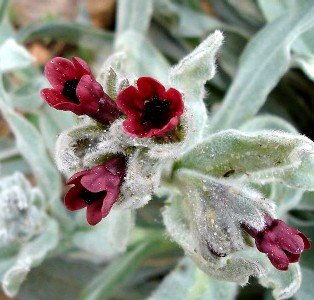
Photo: Jean Tosti - Flowers of Cheirifolium
Rx. Ceruss. calcin. [burnt lead] {3 ounces} Bol. alb. ppt. [white earth precipitate] Tutiæ ppt. [zinc oxide precipitate] Lap. Calamin. ppt. [calamine precipitate] {of each 1 ounce} Myrrh. Oliban. [frankincense] {of each 3 drams} Sal. Tartar. Armon.[iac] {of each 1/2 ounce} Sem. [seeds of] Cumin. Anisi, Levist. [lovage] {of each 5 drams} Bacc. Lauri [bayberry], Juniper. {of each 6 drams} Pulv. fol. [powdered leaves of] Theæ [tea], Savin. [juniper] {of each 1 ounce} Flor. Sambuc. [elder flowers] {1.5 ounce} M. f. Pulvis. Hujus Pulveris. [make this into a powder of] {6 ounces} Lixivii opt. [strong lixivium] {16 ounces} Aq. Plantaginis [plantane water], flor. Sambuc. {of each 20 ounces} Chærifol. [cheirifolium] {15 ounces} coquantur leniter ad tertiae partis humiditatis consumptionem [gently cooked until 1/3 consumed]; hinc remove ab igne [then remove from the fire], & immisce [mix in] Spirit. vini Camphor. {3 ounces} Sperm. Ceti. {1/2 ounce} fiat Lac. Aureatum [make into Lac Auretum]2
For those surgeons not wanting to undertake the making of such a complex prescription, Purmann advises that "The French have a Cataplasm; [which] tho’ very common is very good in this Case." He gives the prescription for this as well, which is quite simple: three ounces of wheat bread crumbs, three egg yolks and half a dram of saffron in 'a sufficient quantity' of cow's milk. This is to be made into a hot poultice that is applied to the affected part.3
Moving on to more specific infections, sea surgeon John Moyle talks about boils which affect 'some the Joints of the Fingers and Roots of the Nails', explaining that one type is benign and the other malign. He dismisses benign boils of the fingers as being "superficial, and
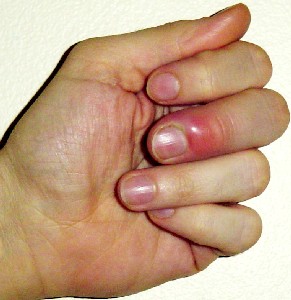
Photo: Chris Craig - Boil at the Root of the Nail
is easily remedied."4 The malign boil is a different matter, which Moyle says results from problems with the body's humors. This boil comes "from adust Choler [the burnt yellow bile humor], and full Phlegm [another bodily humor] mixed, [and] is more difficult [to cure]; especially if it lye deep among the Muscules. 'Tis hot , burns and throbs, and very painful, and long before it comes outward; but (rather if not rightly handled) corrupts inwardly. How many do we see who have lost the Joints of Fingers, (or at least the Use of them) by these kind of Fellons [infections]."5
Since Moyle identifies the problem as arising from the body's humors, he starts his treatment of such boils with the more common humoral balancing treatments: "Bleeding, Purging [using purging medicines containing calomel - purified mercury and either Electuarium Cariocostinum or Pilulæ Rudii], and proper external Applications."6
He then suggests applying a medicine to cause suppuration (the formation of pus) which was thought to be the release of poisonous humors from the wound site. The boil was then to be treated with anodines (soothing medicines) and emollients (softening medicines) to reduce "the violent Heat and Anguish."7 If the boil was particularly virulent, it was to be soaked in warm urine or brandy. Finally, a cataplasm of white bread crumbs mixed with vinegar, oil of roses, oil of myrtles and clarified honey was applied. This was to encourage 'discussion' or disbursement of the matter in the boil.8
In one of his books, military surgeon Richard Wiseman talks about treating 'pterygion' [pterygium unguis] which occurs when the nail's cuticle overgrows the nail. He explains, "A Whitflaw [nail infection] arising about the Nails is often the Cause of this Disease in the Fingers: it is also caused by some Bruise of the flesh under or about the Nails."9 As a result, "pain and Inflammation
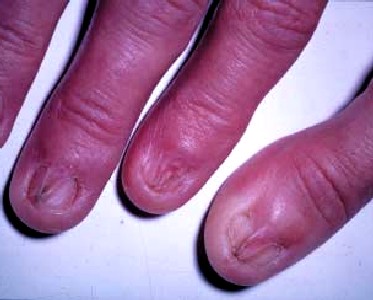
Photo: Mayo Clinic - Pterygium Caused by Lichen Planus
is stirred up, and an eruption of Matter [probably pus] followeth, which being exasperated by a continual pricking or pressure of the Nail, the Ulceration spreads and corrupts it, and thrusts out Excrescences and loose flesh round about."10 If it is left untreated for too long, "the Bone [will] be corrupted, [and] the putrefactive [rotting] Smell will discover it."11
Wiseman says that when the overgrowth only affects the skin, it is easy to cure: "if the Nail be pared away, the Ulceration will soon heal."12 When it has resulted in ulceration, however, the nail must be cut away and medicines applied "which may consume or dry the loose flesh and cicatrize it [heal it with a scar]: in which case you may use a little dry Lint, or Lint dipt in aq. calcis [calcium hydroxide] and dried, or pulv. cort. granat. balaust.[powdered pomegranate rind] terr. Sigillat [sealed earth] lap. tutiae [zinc oxide]; in stronger habits [those of hardier physical constitutions], Merc. precipitat. [mercury precipitate]."13 Such medicines were astringent, drying and healing. Before leaving this subject, Wiseman warns that the surgeon is "to avoid the application of moist or greasy Medicaments, for they rot the Nails, and increase the Ulceration."14
1 Matthias Gottfried Purmann, Churgia Curiosa, 1706, p. 184; 2 Purmann, p. 192; 3 Purmann, p. 184; 4,5 John Moyle, The Experienced Chirurgion, 1703, p. 55; 6,7 Moyle, p. 56; 8 Moyle, p. 57; 9,10 Richard Wiseman, Of Wounds, Severall Chirurgicall Treatises, 1676, p. 59; 11,12,13,14 Wiseman, p. 60
Other Digit-Related Cures
Two other afflictions of the digits are mentioned by period authors - one mundane and the other not.
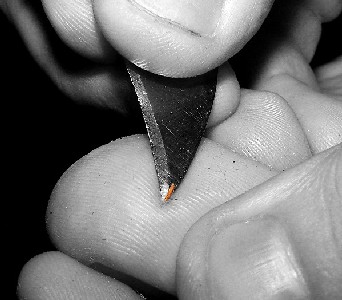
Photo: Wiki User FurryScaly - Removing a Splinter in the Toe
Sea surgeon John Woodall mentions that a surgeon should have "One Bundle of small Instruments usually brought from Germanie conteyning divers kindes as Mulletts, Forceps, Hamules or Hookes, Eare-Pickers, Sikes, Small spatulas, &c."1 This is of interest because Woodall notes that, among other uses, these small instruments were good for removing "a spill [splinter of wood] in the finger"2. While the idea of using a knife to pry out a splinter hundreds of years ago has more grisly appeal to our modern conception of medicine from this time, Woodall was likely talking about the small forceps, or what we would call tweezers.
The second affliction is brought up by military surgeon Raymundus Minderus. He advises his readers that when treating "worms in the Fingers, bruise Parsicaria (Arsmart,) [Persicaria hydropiper] and lay it on; or take of a Piggs Bladder of Gall and put it on the affected Finger like a Thimble."3 'Persicaria hydropeper' is more commonly known as water pepper. It has a strong 'acrid' taste and was thought to be "very detersive [cleansing] and vulnerary [healing]."4 There seems to have been a popular notion that acrid-tasting medicines repelled such parasites.
1 John Woodall, the surgions mate, 1617, p. 17; 2 Woodall, p. 17-8; 3 Raymundus Minderus, Medicina Militaris, 1686, p. 115; 4 Robert James, Pharmacopœia universalis, 1747, p. 399
Case Study: A Wound of the Hand
German military surgeon Matthias Gottfried Purmann noted that "Wounds in the Fingers and Toes, tho’ often slighted, require a diligent and experienced Chirurgeon; for where several Vessels, as Nerves, Arteries, Veins, Tendons, and Muscles occur, and where there is so little Flesh that every Wound reacheth to the Bone, many ill Accidents must necessarily happen upon their being inartificially treated"1.
The august English military surgeon Richard Wiseman provides a detailed and interesting case study for just such a wound. His account is of an Irish sailor who was wounded in the hand during a sea battle. In addition to providing insight into a potential problem faced at sea, this story mentions a rather fascinating complication that also gives insight into some ship's conditions.
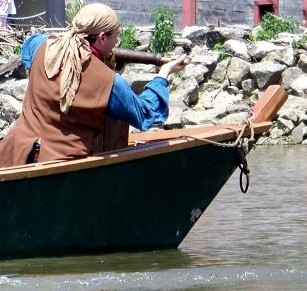
Photo: SoS Boss- The Author Ramming a Charge
Guns can become 'honeycombed' with little holes inside the barrel after many firings. Glowing embers from the previous round can get stuck in these little holes. This is what happened to a mariner on a ship where Wiseman was serving. When the sailor loaded his gun after firing, Wiseman reported, "the Powder took fire, shot the Rammer out of his hand, tearing the Palm of his hand, also some of his Thumb and Fingers. The Wound was not considerable, but the force of the Blow extinguished both sense and motion of the Member."2 Note that best practices for firing black powder weapons include not wrapping your thumb around the rammer so that if it shoots out such a wound will be less likely to occur. They also include swabbing guns with wet sponges to put out such glowing embers.)
Wiseman began his treatment with consideration for the bodily humors. To encourage the formation of pus - he applied "our common Suppurative, (of which at such times we had great quantity ready,)"3. Pus was believed to be the ejection of bad humors from a wound and such medicines were to encourage the formation of pus and prevent the wound from [quite un-ironically] becoming infected.
On top of the suppurative, Wiseman put an unspecified 'restrictive' medicine to stop the bleeding, explaining that had had "then no time for Bleeding him."4
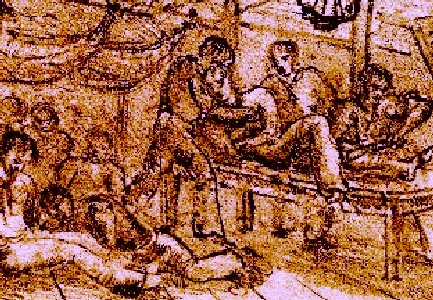
Battle Surgery from
The National Maritime Museums, Greenwich, London (1820)
As mentioned previously, bleeding was another humoral treatment. Blood, one of the four bodily humors, was thought to become corrupted at a wound site and create illness and complications for the patient. So letting an already open wound bleed freely was a quick way to let blood and help prevent this from happening. However, doing so would have required attention by the surgeon or his assistants/mates, who would have had to monitor the bleeding and collect the blood. During sea battles, the surgeon usually had little time for such things, being more concerned with treating life-threatening wounds. So Wiseman simply bandaged the Irishman's hand for later attention.
When the fight was over, he bled the patient (probably not by re-opening the wound, but by 'breathing a vein' in the patient's arm) and 'purged him' a day or two after that to further remove unwanted humors from the body. He then bathed the hand using an oil prepared from earthworms, germander, dill, lily and salve for the nerves.
While the patient was healing and
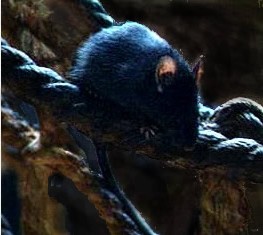
lying asleep in his Hammock, he was wakened by the wet he felt upon his Breast and Belly; and getting up to a Candle, he found the Dressing upon his Hand all bloody, as also the place whereon it lay. I being called took off his greazy Dressings, and found the Palm of his hand and fingers gnawed by Rats. They had eaten through the oiled Cloths, and had gnawed his Hand more, if he had not wakened by the trickling of his blood. [Keep in mind that his hand was probably too numb to feel the rats biting it.]5
Wiseman re-dressed the wound, using digestive medicines "to hasten Suppuration [pus formation], supposing the discharge of Matter might contribute to his Recovery. After I had cured them, I made him a Fontanel in that Arm, and bathed the member frequently, also cupped and scarified [made small incisions in] it; and afterwards applied Plaisters of Pitch, to stir up a heat in the Members."6 Here again we have a variety of humoral treatments designed to prevent further complications (like infections leading to gangrene). A fontanel is an incision the surgeon makes so that he can place an irritant into it which will emit unwanted humors (such as pus and other serums). Cupping involves creating a vacuum over the scarified (incised) flesh using a cupping glass to draw out blood.
The wound eventually was healed, with Wiseman reporting that the sailor "returned to the Navy, and had more use of his Arm."7
1 Matthias Gottfried Purmann, Churgia Curiosa, 1706, p. 183-4; 2,3,4,5 Richard Wiseman, Of Wounds, Severall Chirurgicall Treatises, 1676, p. 437; 6 Wiseman, p. 437-8; 7 Wiseman, p. 438
Syndactyly
Syndactyly occurs when either the fingers or toes are fused together. Military surgeon Richard Wiseman explains how to deal with it quite simply: "Where the Fingers have been all grown to one another almost to the middle Joynts, I have separated them by Scissors and Knife, and afterwards by the Caustick-stone rubbed the Cicatrices [scars] off,
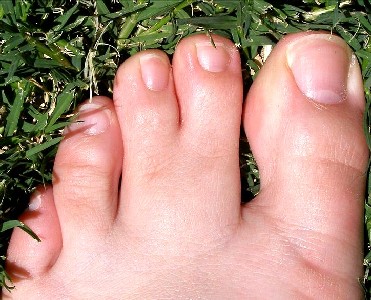
Photo: Wiki User Pschemp - Syndactyly of the Toes
and healed them smooth."1 Caustic stones were potential cauteries such as sodium hydroxide which were used to burn away unwanted skin.
Sea surgeon John Moyle provided a little more detail on the problem and how to treat it. He explained that syndactyly occurred "either from the Birth, or by Accidents (as Burning or Scalding) the Fingers of the Hands, or Toes of the Feet, for want of right Handling at first, grow to each other, or so may other Parts likewise. These are a hindrance to Action, and a Deformity to the Patient."2
He provides two suggestions for curing the problem. The first is "dextrous separating of them by Incision", after which they are to be bandaged seperately using an unspecified balsam (for healing the wound) and plaster (to protect the digits).3
The second suggestion for syndactyly is specifically designed to heal burnt, joined fingers and toes. The wooden world of the ship was in constant threat of ignition during battles and from the careless use of candles and pipes and burns were sometimes the result. In this case, Moyle advised that such digits be wrapped "singly with a Lawn dip'd in [a medicine composed of oil of violets, oil of lilies, oil of roses, oil of sweet almonds, white rose water, two egg yolks, sugar of lead mixed in women's breast milk. This "will Prevent their growing together, and will heal them"4. This was the 'right handling' he mentioned.
Ambroise Paré agrees with Moyle, noting that when fingers grow together "as by a wound, or burn ill cured... being ulcerated do easily grow together, unless they bee kept asunder [apart] by a linnen rag."5 If they do happen to grow together, he suggested cutting them apart with a sharp razor.
1 Richard Wiseman, Of Wounds, Severall Chirurgicall Treatises, 1676, p. 442; 2,3 John Moyle, The Experienced Chirurgion, 1703, p. 142; 4 Moyle, p. 164; 5 Ambroise Paré, The Workes of that Famous Chirurgion Ambrose Parey, 1649, p. 418
Finger Fractures
Sea surgeon John Atkins discusses the treatment of fractures of the fingers. He notes that such fractures are usually accompanied with a wound (making them compound fractures) and that "must be differently treated, as [when] it is the first, second, or third Phalanx."1
When it is the end bone of a finger (the first phalanx), "we need not be hasty
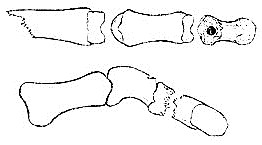
Fractured Finger Bones, From Thomas Annandale (1866)
in the Extirpation [amputation] of that Joint, how irrecoverable it may appear at first; for Nature sometimes exceeds our Expectations; and no doubt it is better a Joint be preserved (tho' clumsily cicatrized [healed]) than lost"2. In this case, Atkins simply suggests treating the wound accompanying the facture and then bandaging it by rolling it in one direction one one day and the other on following days which will "restore the preceding Deflexity [ability to bend]."3
When either of the two bones of the finger closer to the body is broke, "a little more Care and Consideration wanted, both to replace the Bone, and to preserve it"4. Atkins provides a wealth of detail in his description of healing such fractures, so let's read it in full.
And, first, the straightening of a Finger is the replacing of it; if any Particle of Bone is an Obstruction to this, or separated, it is to be removed; and if the Wound be so large as to shew the Bone, it should be covered with dry Lint, or a Dossil [a folded piece of lint] pressed out of Tinct. Myrrh. [tincture of myrrh - said to be good for cleansing, preserving and healing wounds]. To secure the Fracture, I use only a Plaister Compresses, and two Splints [to keep it straight]; Rowling [with a roller bandage] I think inconvenient here, in that it wreaths [moves] the Finger aside, and makes a distorted Unition [of the bone]: The middle Part of the Plaister is to be applied on the Wound, and to come round the Finger, (first cutting out so much as may leave room for Dressing [with medicines]) The two small Splints with each a Compress, I place on the upper and under Part; more than these would be troublesome, and indeed cannot be used, especially in the first Phalanx [the bone closest to the hand]; but that the Pressure may not be unequal, or give Room to the Bone's receding that Way, we supply the want with more little Linnen Compresses, one on each Side; and having tied the whole with a couple of narrow Ligatures, place it to the Breast, to be out of the Way.5
French military surgeon Ambroise Paré also discusses the treatment of fractures of the finger, bringing out an interesting point not fully described by Atkins.
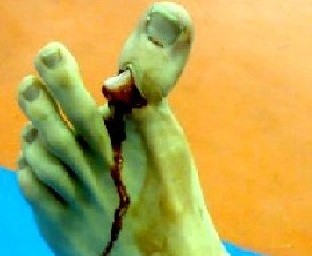
Photo: Wiki User Taopman - Broken Toes with Wound
His first advice is similar to Atkins, suggesting that such broken bones be placed "upon some even and smooth table, and then let your servant stretch forth the broken bones, and the workmaster restore them thus extend them and put them in their proper seats."6 The fractured fingers are then to be bandaged and "tyed or bound to their neighbours, that so they may the more easily, bound to a stake, be kept in the state where they have been put by the hand of the workman."7
The interesting recommendation he adds occurs once the callus forms. Paré orders "the hollowness or palm of the hand shall be filled with a Tennis ball... [so] the fingers themselves shall be kept in the middle posture, that is, not wholly open, nor quite shut."8 This allowed the hand when healed to 'take hold of any thing.'
Paré explains that this is only done for the fingers, not the toes. The setting and dressing of the toes was the same as for the fingers. Once the callus had formed, however, "the bones of the toes must not be kept in a crooked posture, as the bones of the fingers must, lest their action perish or be depraved. For as we use our legs to walk, so we use our feet to stand. Besides the Patient shall keep his bed until they be knit."9
1,2,3 John Atkins, The Navy Surgeon, 1734, p. 22; 4 Atkins, p. 22-3; 5 Atkins, p. 23; 6,7,8 Ambroise Paré, The Workes of that Famous Chirurgion Ambrose Parey, 1649, p. 371; 9 Paré, p. 379

